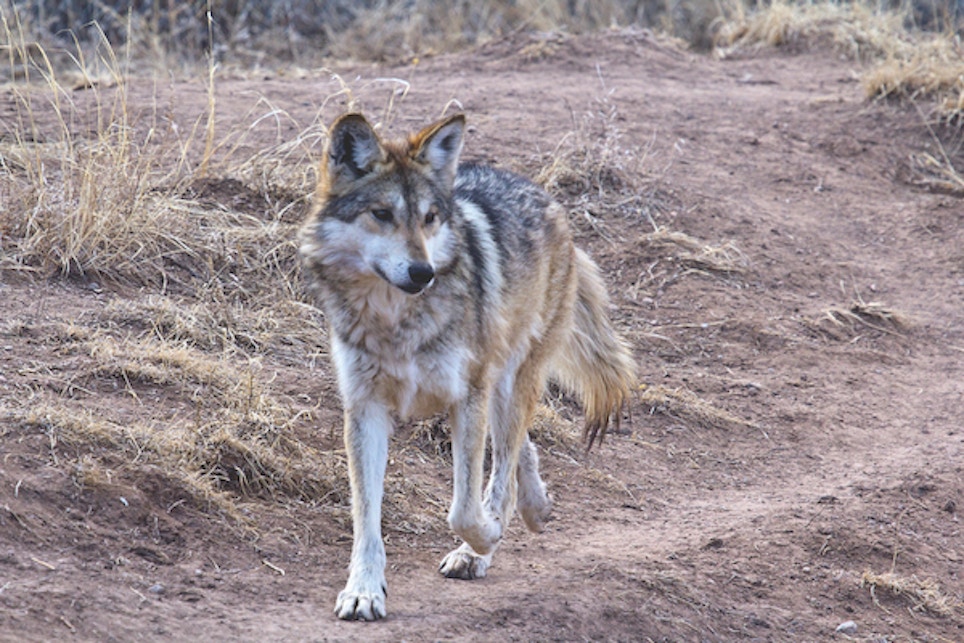
Researchers want to determine to Mexican wolves are having a negative impact on elk herds. Photo: iStock/RoseMaryBush
How do elk respond when an apex predator, once eliminated from the landscape, stages a comeback? Researchers in New Mexico are keen to find out. They are taking a deep look at how southwestern elk herds may be changing their habits as populations of a native predator, the Mexican gray wolf, grow. Currently three years into a four-year study, researchers aim to document elk population dynamics and how they respond to wolves on the landscape. A collaboration between the New Mexico Cooperative Fish and Wildlife Research Unit at New Mexico State University (NMSU), Arizona Game and Fish Department, New Mexico Department of Game and Fish and U.S. Fish and Wildlife Service, the study kicked off in early 2019, led by principal investigator James Cain.
“I hope it will be useful for management of Mexican wolves and elk in the Southwest,” said Cain, an NMSU professor and assistant unit leader for the New Mexico Cooperative Fish and Wildlife Research Unit. “Ideally, it will have implications for management in other systems as well.”
The last time wolves had any appreciable impact on southwestern elk herds dates back to the 19th century. Back then, Mexican gray wolves roamed parts of Mexico, Arizona, New Mexico and Texas. But by the late 1800s, waning numbers of elk and other native ungulates increased wolf predation on livestock. That only accelerated a coordinated campaign by federal and state agents and ranchers to eradicate them through poisoning, trapping and shooting. By the mid-1900s, wolves fell silent north of the Mexican border.
In 1976, they were protected under the Endangered Species Act, and management pivoted to raising the few remaining animals in captivity in a bid to save them from extinction. In 1998, Mexican wolves were released back to the wild for the first time in the Blue Range Wolf Recovery Area along the Arizona/New Mexico border. After a long period of stagnation, wolf numbers have nearly doubled over the past five years to at least 186 wolves at last count in 2020, according to the U.S. Fish and Wildlife Service. That’s halfway to the population threshold needed for declaring them successfully recovered — a milestone for a species once on the precipice of extinction.
But it also begs the question of how wolves’ primary prey in this region — elk — may respond. “In the past several years, wolves had exponential population growth compared to the decade prior where growth was very slow,” said Cara Thompson, a NMSU Department of Fish, Wildlife and Conservation Ecology master’s student who presented preliminary findings at a workshop this past August. “With the number of wolves increasing on the landscape, the magnitude of their effect on elk may also increase.”
One question researchers hope to answer is whether growing wolf numbers will alter elk behavior, demographics and movements, possibly leading to declining nutrition from reduced foraging time, increased stress levels and use of lower quality habitat. Or, elk could reduce the effects of predators through behavioral changes such as increased vigilance or multitasking. When elk are head-down taking bites of grass, it takes away their focus from predators. But if they remain too vigilant, they won’t get enough to eat.
“That can be a big cost,” Cain said. The “multitasking” part comes after they grab a bite and as they chew are alert and watching for predators, or later on if they remain alert while chewing their cud. If elk become better multitaskers, researchers speculate that could help offset the costs of increased vigilance due to wariness around wolves.
The study is also examining if wolves are changing elk resource selection, which could help managers anticipate changes in elk behavior if Mexican wolf numbers keep growing. It’s also looking at whether predation risk — influenced by the presence of wolves, density of kills, landscape openness and other factors — is causing elk to rest or forage in alternate locations documented by GPS data from collared elk and wolves. Researchers are also assessing if elk are seeking the protection of human developments or spots without many wolves as low-risk “islands” to limit predation, or if they tend to visit riskier places at lower-risk times such as at midday.
Elk are responding to wolves. Although that might seem straightforward, it’s also really good to be able to document that,” said Zack Farley, another NMSU master’s student working on the project.
The research is still too preliminary to make any determinations about elk behavior or population-level changes, but Cain says he is hopeful the findings will help inform decisions in this new era of wolf population growth. “It’s been needed for a while,” he said. “I think knowing how the different sources of mortality are interacting with each other and how they’re influencing population growth will allow state wildlife agencies to change management if needed.”
RMEF’s Take: We support the ongoing research into the predator-prey dynamics in the heart of southwestern elk country and believe Mexican gray wolf restoration must account for wolves’ impacts on other wildlife and livestock, as well as hunters, to help sustain the renowned elk herds of this region. RMEF also believes Mexican gray wolf recovery should remain focused on the current restoration zones, with no expansion northward beyond their historic range. The recent population gains of wolves in the Southwest are yet another example of a successful federal/state partnership in carnivore conservation and should imbue confidence in eventual state management of this predator.





